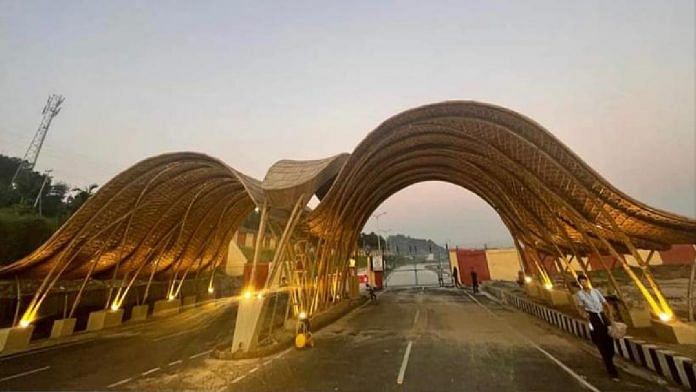Guwahati: A 23 ft tall and 82 ft wide bamboo gate inspired by the hornbill is a herald of change in India’s easternmost state of Arunachal Pradesh. Spread over an area of 2,500 sq ft, its awe-inspiring sweeping arcs tower over the newly-constructed Donyi Polo airport in Hollongi, close to the state capital of Itanagar.
The airport is expected to be a game-changer for the landlocked state, which shares a border with China to the north and northeast, Myanmar to the east, and Bhutan to the west. Hopes of improved connectivity, tourism and economic growth are riding on Donyi Polo airport.
Prior to the Donyi Polo airport, the state had three airports at Pasighat in East Siang district, Tezu in Lohit district, and as of last month, Ziro in Lower Subansiri district.
“The capital city wasn’t connected by an airport before. Right now, we have tourists coming to the western and eastern belt. So, the airport will be great for tourism in the central belt,” said Swapnil Naik, secretary at the civil aviation department of the Arunachal government.
“Bigger commercial flights wouldn’t land at Pasighat and Tezu,” said architect Aroty Panyang, who conceptualised the bamboo gate. “This [Donyi Polo airport] is very good for our state and people. It will make everything much more accessible and connected.”
In the initial phase, low-cost carriers IndiGo and FlyBig will run flights from Hollongi. IndiGo will start services on 28 November, with flights to Kolkata and Mumbai, on all days except Wednesday. Cost of the flights were around Rs 4,000 and Rs 10,000 respectively at the time of publishing.
FlyBig will operate flights to Guwahati, but a schedule is yet to be announced.
Also Read: Fancy a trip to Arunachal? Domestic tourism on rise despite global slump, say experts
17-year journey
Conceptualised in 2005, the airport received in-principal approval in January 2019. It was completed in September this year after which the Union Cabinet decided to change its name from Greenfield Airport to ‘Donyi Polo’, after one of the major indigenous tribal faiths practised in the state.
Arunachal Pradesh Chief Minister Pema Khandu said Tuesday that the airport will “improve connectivity and open new economic avenues”.
Donyi Polo Airport, whose foundation was laid by Hon PM Shri @narendramodi Ji, will improve connectivity & open new economic avenues.
Shri @aadityahbti, a bright young officer, throws light on how the Airport will fulfil aspirations of people.
— Pema Khandu པདྨ་མཁའ་འགྲོ་། (@PemaKhanduBJP) November 8, 2022
It was built at a cost of Rs 645 crore by the Airports Authority of India (AAI) with assistance from the central and state governments.
While the AAI was responsible for the interior of the terminal building, the state government constructed the elements that included the airport road and compound wall, Naik said.
The terminal has the capacity to handle 300 passengers during peak hours.
A press release issued by the AAI explained that the airport has a 2,300 metre-long runway which makes it suitable for the operation of Airbus A320s. Apart from a tarmac that can accommodate three Airbus A320s, the airport will also be able to accommodate four Mi-17 helicopters, according to the press release.
Also Read: Alcohol, men, night concerts—yet, Arunachal’s Ziro music festival is safest for Indian women
The hornbill
Even before the inauguration, pictures of the airport’s gate went viral. The awe-striking gate was evidently inspired by the Great Hornbill — the state bird of Arunachal Pradesh.
The construction work of Donyi Polo Airport, Itanagar @aaihollongi is completed and the airport will soon commence flight operations. The huge state-of-the-art entry gate at the airport is built up of bamboo showcasing the shape of the state bird- the Great Hornbill. pic.twitter.com/UTzmBwtudl
— Airports Authority of India (@AAI_Official) November 8, 2022
“We wanted a concept which the local people could relate to. We mostly used bamboo and in the interior, we used cane,” said Panyang, who hails from East Siang district. “It took us 5 months and 15 artisans to build the gate.”
Its size allows for free movement of heavy vehicles.
The hornbill holds great cultural significance in Arunachal Pradesh, especially for the Nyishi tribe — the largest ethnic group of the state. Earlier most Nyishi men used to adorn a headgear that consisted of a woven cane cap with the upper beak and casque of the hornbill. In recent years, given the bird’s ‘vulnerable’ status, the community has turned to plastic and fibreglass alternatives.
(Edited by Theres Sudeep)
Also Read: Indians are travelling again, boosting tourism & demand in airline fuel in the country



